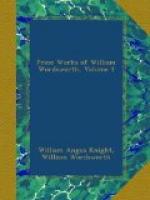He was a man of ardent feeling, and his faculties of mind, particularly his memory, were extraordinary. Brief notices of his life ought to find a place in the History of Westmoreland.
321. ‘Return’ and ‘Seathwaite Chapel.’ [Sonnets XVII. and XVIII.]
The EAGLE requires a large domain for its support: but several pairs, not many years ago, were constantly resident in this country, building their nests in the steeps of Borrowdale, Wastdale, Ennerdale, and on the eastern side of Helvellyn. Often have I heard anglers speak of the grandeur of their appearance, as they hovered over Red Tarn, in one of the coves of this mountain. The bird frequently returns, but is always destroyed. Not long since, one visited Rydal lake, and remained some hours near its banks: the consternation which it occasioned among the different species of fowl, particularly the herons, was expressed by loud screams. The horse also is naturally afraid of the eagle.—There were several Roman stations among these mountains; the most considerable seems to have been in a meadow at the head of Windermere, established, undoubtedly, as a check over the Passes of Kirkstone, Dunmailraise, and of Hardknot and Wrynose. On the margin of Rydal lake, a coin of Trajan was discovered very lately.—The ROMAN FORT here alluded to, called by the country people ‘Hardknot Castle,’ is most impressively situated half-way down the hill on the right of the road that descends from Hardknot into Eskdale. It has escaped the notice of most antiquarians, and is but slightly mentioned by Lysons.—The DRUIDICAL CIRCLE is about half a mile to the left of the road ascending Stone-side from the vale of Duddon: the country people call it ‘Sunken Church.’
The reader who may have been interested in the foregoing Sonnets, (which together may be considered as a Poem,) will not be displeased to find in this place a prose account of the Duddon, extracted from Green’s comprehensive Guide to the Lakes, lately published. ’The road leading from Coniston to Broughton is over high ground, and commands a view of the River Duddon; which, at high water, is a grand sight, having the beautiful and fertile lands of Lancashire and Cumberland stretching each way from its margin. In this extensive view, the face of Nature is displayed in a wonderful variety of hill and dale; wooded grounds and buildings; amongst the latter Broughton Tower, seated on the crown of a hill, rising elegantly from the valley, is an object of extraordinary interest. Fertility on each side is gradually diminished, and lost in the superior heights of Blackcomb, in Cumberland, and the high lands between Kirkby and Ulverstone.
’The road from Broughton to Seathwaite is on the banks of the Duddon, and on its Lancashire side it is of various elevations. The river is an amusing companion, one while brawling and tumbling over rocky precipices, until the agitated water becomes again calm by arriving at a smoother and less precipitous bed, but its course is soon again ruffled, and the current thrown into every variety of form which the rocky channel of a river can give to water.’—Vide Green’s Guide to the Lakes, vol. i. pp. 98-100.




